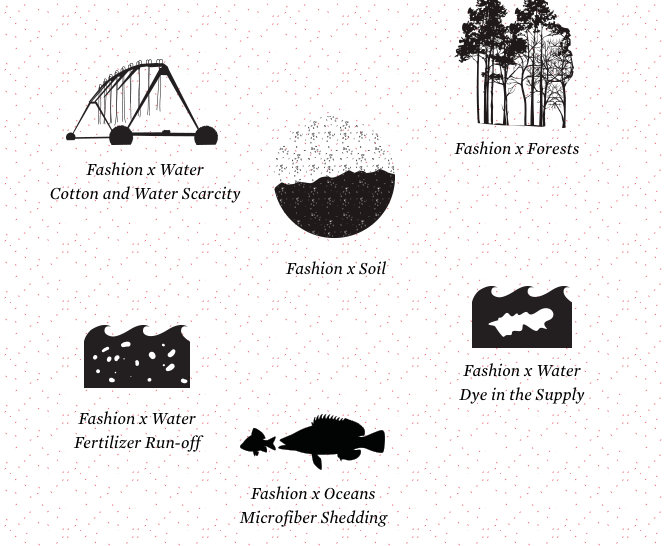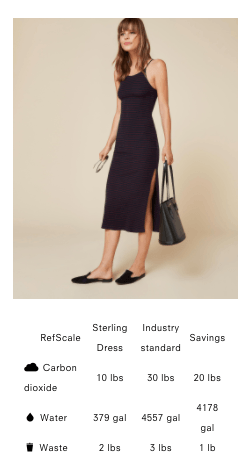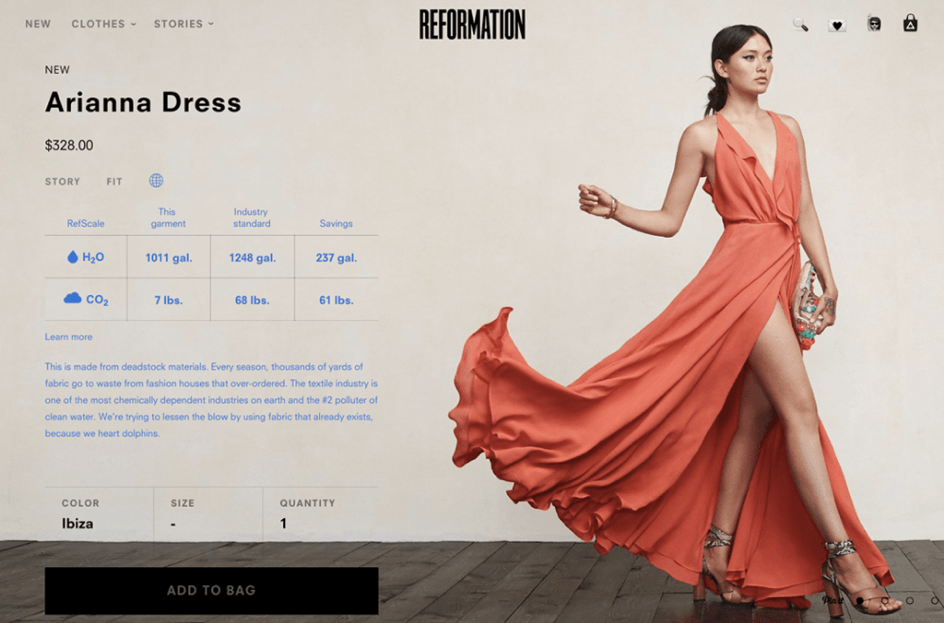Reformation: Making Sustainability Trendy

Reformation is a fashion B-Corp, whose mission is to disrupt fashion can combat climate change through sustainability.
Facts about the Fashion Industry
The apparel industry accounts for 10% of global carbon emissions and remains the second largest industrial polluter, second only to oil. The United States apparel industry accounts for one third of the $3 trillion dollar global industry. [i]
The impact the fashion industry has on the environment is astonishing.
– Fast fashion garment, which are worn less than 5 times and kept for 35 days produce over 400% more carbon emissions per item per year than garments worn 50 times and kept for more than a year. [1]
– Nearly 70 million barrels of oil are used each year to make the world’s polyester fiber, which is now the most commonly used fiber in our clothing. But it takes more than 200 years to decompose. [1]
– More than 150 billion garments are produced annually, enough to provide 20 new garments to every person on the planet, every year. [1]
– Americans throw away about 70lbs of clothing per person every year. [1]
– The fashion industry is the second biggest polluter of freshwater resources on the planet. [1]
These facts, along with the documentary, “The True Cost”[ii], which chronicles the environmental and human rights violations of the fashion industry have changed my personal buying habits as a consumer. I no longer shop at fast fashion retailers H&M and Forever 21. But what’s the alternative?
Sustainability at Reformation
Reformation is a fashion B-Corp making sustainability trendy. Created in 2009, Reformation’s mission is to lead and inspire a sustainable way to be fashionable.[iii] They are achieving this mission in the following ways:
- RefScale: Reformation tracks the environmental footprint of each garment produced and displays that information on each product page. The RefScale measures the pounds of carbon dioxide emoted, gallons of water used, and pounds of waste generated. This information is then
 compared to most clothes bought in the US.[iv]
compared to most clothes bought in the US.[iv] - Factory: Reformation employs a Green Building model, employing energy efficient appliances, electricity provided by 100% wind power, and a garden that recycles used water. They have a goal of becoming zero waste and are currently at 75%. [4]
- Employees: Reformation has a goal of paying all employees above the Los Angeles living wage. They currently pay over 75% of employees at this level. Over 75% of the workforces consists of women and underrepresented minorities.[4] Benefits include metro passes to encourage use of public transportation.[4]
- Retail: Reformation only sells online and in their own boutiques. They outfit their stores with sustainable practices including reusable totes, recycled hangers, and a clothing recycling program.[4]
Potential Challenges:
I fully support how Reformation is attempting to transform the fashion industry. However, the problem is so widespread that it will take more than just a few start-ups trying to make a difference. It will require an entire transformation in how the fashion industry operates as well as how consumers make purchase decisions.
Scalability
How scalable is this model? The fashion industry is so massive and the fast fashion epidemic is primarily due to the mass market consumer. In order to achieve real change, it will require industry overhaul. All major retailers and manufacturers will need to change their business models to focus on sustainability. One way to potentially achieve this is through increased regulation. Requiring companies to have sustainable manufacturing and employment practices will force fashion’s hand. However, increased regulation could lead to increase prices of clothing.
Consumers
Consumers need to be educated on the role they play in polluting the environment through fashion. They need to understand how the clothes they buy are made and the impact it has on the environment. I think if consumers were more educated on how fashion contributes to climate change and that their donated clothes will most likely end up in a landfill, they would change their behavior. This is especially true of US consumers who contribute most to the problem. However, this is easier said than done. The ability to buy cheap, trendy clothes makes consumers feel as though they have more purchasing power and status. Fashion has strong ties to personal identity. People with less money to spend are less likely to save in order to buy more expensive clothing.
Company
Will Reformation be able to move from niche to mainstream? I would consider Reformation to be in the Affordable Luxury segment. Their price point is high for the mass market customer, but not unreachable. Beyond being sustainable, they produce clothes that are on trend and fashion forward. If they are able to find a way to reduce costs through scaling the business, I believe they have a lot of potential.
Word Count: 774
[i] http://www.forbes.com/sites/jamesconca/2015/12/03/making-climate-change-fashionable-the-garment-industry-takes-on-global-warming/#940b9f6778a2
[ii] http://truecostmovie. com/
[iii] https://www.thereformation.com/whoweare#
[iv] https://www.thereformation.com/whoweare#factoryLife
https://zady.com/takeaction




Tracy, thanks for the enlightening article! The figures you provided in beginning, particularly the one about the average American disposing of 70lbs of clothing/year, was shocking! I completely agree that consumers need to be educated about how their purchasing decisions affect the environment. Additionally, educating consumers on why certain products are more expensive will help consumers justify those purchases that will stay in their closets for longer (i.e. not have as negative an impact on the environment). One point I want to push on is Reformation’s potential to scale and educate the market. My feeling is that they are priced too high to have a sizable impact.
Tracy, great article – I had no idea that Reformation was thinking so deeply about the environmental impact of the fashion industry. I completely agree with you that consumers need to be better educated about the products they are purchasing. I also wonder how Reformation can be more proactive about the recycling of their clothes and the reusability of fashion – given the shift towards wearing a piece of clothing only 5 times! For example, is Rent the Runway the most environmentally friendly fashion company by reusing garments that would typically only be worn once or twice? Should retail companies be thinking about their business model completely differently (renting clothes) in order to fill the demand for fast fashion and make sure they are being sustainable?
Thanks for the interesting post, Tracy! There are other fashion startups trying to combat this trend in various ways. For example, Cuyana’s mantra of “fewer, better things” encourages consumers to pay a bit more for timeless, high quality products that will last a long time. The idea is that ultimately, Cuyana customers will need to have fewer items in their closets, leading to less waste/excess. While I think this is a great idea, I agree with harajuku girl that none of the startups in this space are currently large enough to impact the sustainability of the industry as a whole – large fast fashion companies like H&M really have to be at the vanguard driving change or it won’t happen.
On their website, H&M recognizes that sustainability is an important issue, and touts various initiatives they have undertaken to promote sustainability, including a recycling program. The recycling program works like this: you can take old clothes (even if they’re not from H&M) to any H&M store, and their partner will sort them into three categories – rewear (sold to second-hand stores), reuse (make into rags, etc.) and recycle (into textile fibers for things like insulation). Here is a link to the website with more details: http://about.hm.com/en/sustainability/get-involved/recycle-your-clothes.html. My question for Tracy is, do you think H&M’s commitment to sustainability is credible given the nature of their business? I see a lot of parallels between H&M’s situation and the Ikea case – both companies sell “disposable” products and need to figure out how to be sustainable nonetheless.
Wow! Thanks for sharing this Tracy, I had no idea that the fashion industry had such a huge carbon-footprint!
In general, I think this speaks to a larger gap in consumer knowledge of true costs of clothing. For example, mass retailers such as Walmart and Target have conditioned consumers to expect “typical” prices for everyday garments well below $10 (see here for a quick search on Walmart.com: https://www.walmart.com/c/kp/tee-shirts), but these are predicated on miniscule labor costs which may or may not represent unfair trade practices (quick infographic for example here: http://www.cnn.com/2013/05/02/world/asia/bangladesh-us-tshirt/index.html).
Given that most customers have such low expectations for clothing prices, do you have any ideas for how to persuade the average consumer to “buy green”? From the article above, it seems like Reformation is targeting a more affluent customer base which may make a voluntary switch from traditional brands to more sustainable ones. Do you think consumer education or stricter regulations are the right way to go to have a broad impact here?
Thanks for the post Tracy. Your post caught my attention after reviewing Priya’s post on sustainability issues caused by fast fashion retailers – Reformation is seeking to challenge the fast fashion model in many ways. You really highlight the core issue with Reformation’s positioning, though, which is its higher pricepoint and its positioning in the affordable luxury space. In order for Reformation to fulfill its sustainability promise to the consumer, it requires a high price point to fund its business model. For those who call on Zara and H&M to change their business models, how do we weigh the trade off between improved sustainability for our planet against asking consumers to spend an ever increasing portion of their income on clothing they may not be able to afford at a higher price point? What if it means forgoing other important basic necessities like food or health spending? Each of these decisions come with difficult trade-offs.
Great post, Tracy! Those figures at the beginning are pretty staggering. You mention that increased regulation would lead to an increase in the price of clothing. Do you think this might be a desirable outcome? It would force consumers to internalize the environmental costs of their clothing, which are currently an externality borne only by the environment and those unfortunate enough to be harmed by environmental degradation and climate change. Higher prices, even at the lower end of the market, would force people to think twice about buying as much clothing as they do and would encourage them to seek out more durable options. Though this disproportionately affects lower income consumers, I think this would be necessary to drive the real behavioral changes that are necessary (in addition to the production changes that producers need to undertake). Thanks for sharing this! It seems like a really cool company.